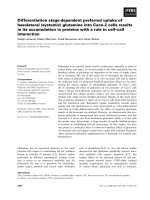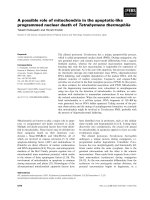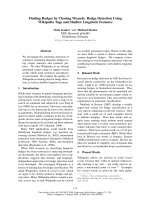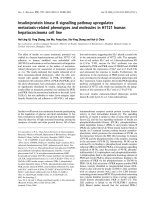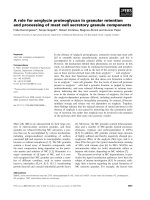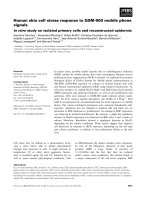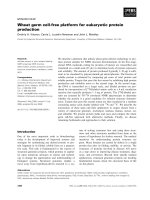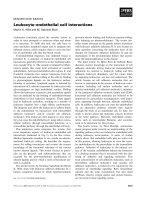Báo cáo khoa học: "Autologous somatic cell nuclear transfer in pigs using recipient oocytes and donor cells from the same animal" pdf
Bạn đang xem bản rút gọn của tài liệu. Xem và tải ngay bản đầy đủ của tài liệu tại đây (252.89 KB, 7 trang )
JOURNAL OF
Veterinary
Science
J. Vet. Sci. (2007), 8(4), 415
421
*Corresponding author
Tel: +82-33-250-8670; Fax: +82-33-244-2367
E-mail:
Autologous somatic cell nuclear transfer in pigs using recipient oocytes
and donor cells from the same animal
Eunsong Lee
1,
*
, Kilyoung Song
2
1
School of Veterinary Medicine and Institute of Veterinary Science, Kangwon National University, Chunchon 200-701, Korea
2
College of Veterinary Medicine, Seoul National University, Seoul 151-742, Korea
The objective of the present study was to examine the
feasibility of the production of autologous porcine somatic
cell nuclear transfer (SCNT) blastocysts using oocytes and
donor cells from slaughtered ovaries. Therefore, we at-
tempted to optimize autologous SCNT by examining the
effects of electrical fusion conditions and donor cell type
on cell fusion and the development of SCNT embryos.
Four types of donor cells were used: 1) denuded cumulus
cells (DCCs) collected from in vitro-matured (IVM) oo-
cytes; 2) cumulus cells collected from oocytes after 22 h of
IVM and cultured for 18 h (CCCs); 3) follicular cells ob-
tained from follicular contents and cultured for 40 h
(CFCs); and 4) adult skin fibroblasts. The DCCs showed a
significantly (p
<
0.01) lower rate of fusion than the CCCs
when two pulses of 170 V/mm DC were applied for 50
µ
sec
(19
±
2% vs. 77
±
3%). The rate of DCC fusion with oo-
cytes was increased by the application of two DC pulses of
190 V/mm for 30
µ
sec, although this was still lower than
the rate of fusion in the CCCs (33
±
1% vs. 80
±
2%). The
rates of cleavage (57
±
5%) and blastocyst formation (1
±
1%) in the DCC-derived embryos did not differ from
those (55
±
6% and 3
±
1%, respectively) in the CCC-de-
rived SCNT embryos. Autologous SCNT embryos derived
from CFCs (5
±
2%) showed higher levels of blastocyst
formation (p
<
0.01) than CCC-derived autologous SCNT
embryos (1
±
0%). In conclusion, the results of the present
study show that culturing cumulus and follicular cells be-
fore SCNT enhances cell fusion with oocytes and that
CFCs are superior to CCCs in the production of higher
numbers of autologous SCNT blastocysts.
Key words: autologous, cumulus cells, follicular cells, nuclear
transfer, pigs
Introduction
Nuclear transfer (NT) techniques that use a variety of so-
matic cells have been used to produce genetically superior
animals or transgenic animals that can secrete valuable
proteins or pharmaceuticals used in human medicine in
their urine or milk [3,14,17], as well as to establish embry-
onic stem cell lines in several mammalian species [9,35]. It
is currently possible to produce somatic cell-cloned ani-
mals from several mammalian species, including cattle,
pigs, horses, and sheep [10,14,25,38]. The pig has been
widely used as a target animal for the generation of a
bio-organ donor for xenotransplantation by deleting or in-
serting specific genes that are associated with the human
immune system [16,27,32].
The mass production of somatic cell nuclear transfer
(SCNT) embryos is usually carried out using immature pig
oocytes that are obtained from slaughtered ovaries and
used as cytoplasts after in vitro maturation (IVM). Howe-
ver, these slaughterhouse-derived oocytes originate from
various maternal lineages and therefore have different
types of mitochondrial DNA (mtDNA) depending on their
origin. SCNT embryos prepared from recipient oocytes
and donor cells with different maternal lineages are not
true clones, but are rather genetic copies with mtDNAs
from two different sources. Together with the reprogram-
ming of donor cell nuclei in recipient oocytes, previous
studies have demonstrated that mtDNA influences the in
vitro developmental capacity of SCNT embryos and the
normality of newborn animals derived from SCNT em-
bryos [7,22]. It has also been reported that the fusion rate
and the number of transferable blastocysts are affected by
the source of recipient oocytes in bovine SCNT [4] and that
heterologous mtDNA introduced by NT of donor cells in-
fluences the in vitro development of SCNT mouse em-
bryos [22]. Mitochondria mediate cell metabolism,
growth, and differentiation by means of ATP production.
In addition to these physiological roles, mitochondria are
416 Eun Song Lee et al.
known to influence the economic value of domestic ani-
mals due to their influence on meat quality, milk yield
traits, and fertility [20,21,28,31]. It is necessary to estab-
lish an efficient system for the generation of autologous
SCNT embryos in order to apply SCNT to the production
of a superior animal with maternally inherited traits
[11,33,34]. In cattle, autologous SCNT was used to exam-
ine the effect of nuclear-cytoplasmic interactions on em-
bryo viability in vitro and in vivo [4,12,39], but there are
few reports on autologous SCNT in pigs.
The objective of the present study was to examine the fea-
sibility of producing autologous porcine SCNT blastocysts
using autologous oocytes and donor cells from slaughtered
ovaries. Therefore, we attempted to optimize autologous
pig SCNT by examining the effects of electrical fusion and
donor cell type on cell fusion and the subsequent in vitro
development of porcine SCNT embryos.
Materials and Methods
Culture media
All chemicals were purchased from Sigma-Aldrich (USA),
unless otherwise stated. IVM was carried out in TCM-199
media (Invitrogen, USA) supplemented with 10% (v/v)
porcine follicular fluid, 0.6 mM cysteine, 0.91 mM pyr-
uvate, 10 ng/ml epidermal growth factor, 75 µg/ml kana-
mycin, and 1 µg/ml insulin. Porcine follicular fluid (pFF)
was collected from follicles of 3-8 mm in diameter, centri-
fuged at 1900 × g for 15 min, filtered through a 0.2-µm fil-
ter, and stored at 30
o
C until use. The same batch of pFF
was used in all experiments. The in vitro culture (IVC) me-
dium for embryo development was North Carolina State
University 23 medium containing 0.4% (w/v) bovine se-
rum albumin (BSA) [24], which was modified by replacing
glucose with 0.5 mM pyruvate and 5.0 mM lactate [23].
Oocyte collection and IVM
Porcine ovaries were collected from prepubertal gilts at a
local slaughterhouse and transported to the laboratory in
saline at approximately 37
o
C. Follicles of 3-8 mm in diam-
eter were aspirated using an 18 G needle fixed to a 10-ml
disposable syringe, and the follicular contents were pooled
into 15-ml conical tubes and allowed to settle as sediment.
The sediment was suspended in HEPES-buffered Tyrode's
medium (TLH) containing 0.05% (w/v) polyvinyl alcohol
(PVA) (TLH-PVA) [1] and observed under the microscope.
Only cumulus-oocyte complexes (COCs) with more than
three layers of compact cumulus cells were selected for
IVM. For the autologous SCNT in Experiment 3, immature
oocytes from pairs of ovaries from individual pigs were
collected and matured separately. All oocytes, with the ex-
ception of morphologically degenerated oocytes, were cul-
tured for IVM to obtain as many oocytes as possible during
autologous SCNT. After washing twice in TLH-PVA and
once in IVM medium, groups of 20-80 COCs were placed
into individual wells of a 4-well multi-dish (Nunc, Den-
mark) that contained 500 µl of IVM medium with 5 IU/ml
eCG (Intervet, Holland) and 5 IU/ml hCG (Intervet,
Holland). COCs were cultured at 39
o
C in a humidified at-
mosphere of 5% CO
2
in air. After 22 h of maturation culture,
the COCs were washed three times in fresh, hormone-free
IVM medium and then cultured for an additional 18 h.
Preparation of donor cells
Four types of somatic cells were used as donor cells: 1)
denuded cumulus cells (DCCs); 2) cultured cumulus cells
(CCCs); 3) cultured follicular cells (CFCs); and 4) adult
skin fibroblasts. DCCs were collected from IVM oocytes
by repeated pipetting in IVM medium that contained 0.1%
(w/v) hyaluronidase, washed twice in TLH-PVA by cen-
trifugation, and resuspended in TLH containing 0.4%
(w/v) BSA (TLH-BSA) prior to nuclear transfer. CCCs
collected from oocytes at 22 h of IVM were cultured for 18
h. Follicular cells collected from the follicular contents at
the time of oocyte aspiration were washed twice in
TLH-PVA by centrifugation and cultured for 44 h before
use. Pig ear skin fibroblasts were cultured until contact in-
hibited, as described previously [15,37]. The cells were
cultured in Dulbecco's modified Eagle medium with nu-
trient mixture F-12 (Invitrogen, USA) supplemented with
10% fetal bovine serum, with the exception of DCCs. The
cells were then trypsinized, centrifuged, and resuspended
in TLH-BSA prior to use.
Nuclear transfer
The base medium for oocyte manipulation was cal-
cium-free TLH-BSA containing 5 µg/ml cytochalasin B.
After 40 h of maturation culture, denuded oocytes were in-
cubated for 15 min in a manipulation medium that con-
tained 5 µg/ml Hoechst 33342, washed twice in fresh me-
dium, and then placed into a manipulation medium droplet
that was overlaid with mineral oil. Metaphase II (MII) oo-
cytes were enucleated by aspirating the first polar body and
MII chromosomes using a 17-µm beveled glass pipette
(Humagen, USA), and enucleation was confirmed under
an epifluorescent microscope (TE300; Nikon, Japan).
After enucleation, a single cell was inserted into the peri-
vitelline space of each oocyte. Cell-oocyte couplets were
placed on a 1-mm fusion chamber that was overlaid with 1
ml of 280 mM mannitol that contained 0.001 mM CaCl
2
and 0.05 mM MgCl
2
. Membrane fusion was induced by ap-
plying an alternating current field of 2 V, 1 MHz for 2 sec,
followed by two direct current (DC) pulses of 170 V for 50
µsec or 190 V for 30 µsec using a cell fusion generator
(LF101; NepaGene, Japan). The oocytes were incubated
for 1 h in TLH-BSA and examined for fusion under a ster-
eomicroscope prior to activation.
Autologous somatic cell nuclear transfer in pigs 417
Tabl e 1 . Fusion rates of reconstructed oocytes in relation to electrical field strength and donor cell type
Electrical field strength
Type of donor cell
Denuded cumulus cells Cultured cumulus cells
No. of oocytes Fused, % No. of oocytes Fused, %
170 V/mm, 50 μsec, two pulses 103 19 ± 2
a,A
120 77 ± 3
B
190 V/mm, 30 μsec, two pulses 100 33 ± 1
b,A
119 80 ± 2
B
ab
Within a column, values with different superscripts are significantly different (p<0.01).
AB
Within a row, values with different superscript
s
are significantly different (p<0.01).
Tabl e 2 . In vitro development of somatic cell nuclear transfer embryos derived from denuded (DCC) or cultured cumulus cells (CCC
)
Type of
donor cell
Reconstruction Embryo development
Cell number in
blastocyst
No. of oocytes Fused, % No. of embryos ≥ 2-cell, % Blastocyst, %
DCC 263 31 ± 1
a
80 57 ± 5 1 ± 1 28 ± 0
CCC 129 75 ± 2
b
95 55 ± 6 3 ± 1 33 ± 3
ab
Within a column, values with different superscripts are significantly different (p < 0.01).
Activation and embryo culture
Reconstructed oocytes were activated by two pulses of
120 V/mm DC for 60 µsec in 280 mM mannitol that con-
tained 0.01 mM CaCl
2
and 0.05 mM MgCl
2
. The oocytes
were thoroughly washed in IVC medium, transferred into
30-µl droplets of medium under mineral oil, and cultured
for 6 days at 39
o
C in a humidified atmosphere of 5% CO
2
,
5% O
2
, and 90% N
2
. Cleavage and blastocyst formation
were evaluated on Days 2 and 6, respectively (the day of
SCNT was designated as Day 0). The total cell numbers in
the blastocysts were assessed using Hoechst 33342 stain-
ing under an epifluorescent microscope.
Experimental design and statistical analysis
All of the oocytes used in the respective experiments were
randomly allocated to each treatment group, and at least
three replications were performed in each experiment. In
Experiment 1, SCNT embryos were produced using two
types of donor cells (DCC and CCC). The cell fusion rate
was examined after applying two electrical fusion stimuli
to CCCs and DCCs (2 × 2 factorial design). The in vitro de-
velopmental capacities of the SCNT embryos derived from
DCCs or CCCs were examined in Experiment 2. Based on
the results of Experiment 1, two DC pulses of 190 V/mm
for 30 µsec and 170 V/mm for 50 µsec were applied to the
DCCs and CCCs, respectively, in order to fuse the cell with
a cytoplast. In Experiments 1 and 2, SCNT embryos were
produced by donor cells of heterologous origin. In Experi-
ment 3, autologous SCNT embryos were produced using
CCCs or CFCs as donor cells, and their in vitro devel-
opmental potentials were examined. In addition, the devel-
opmental capacities of the autologous SCNT embryos
were compared with those of heterologous SCNT embryos
derived from adult skin fibroblasts.
The data were analyzed using the general linear model
procedure in the Statistical Analysis System version 9.1
software (SAS Institute, USA), followed by the least sig-
nificant difference mean separation procedure when treat-
ments differed at p < 0.05. Percentage data were subjected
to arcsine transformation before analysis in order to main-
tain the homogeneity of variance. The results are expressed
as mean ± SE of the mean.
Results
Effects of electrical field strength and donor cell
type on fusion (Experiment 1)
Two electrical field strengths were applied to recon-
structed oocytes derived from DCCs or CCCs. As shown in
Table 1, the application of two DC pulses of 190 V/mm for
30 µsec resulted in a significantly (p < 0.01) higher fusion
rate (33 ± 1%) than the application of two DC pulses of 170
V/mm for 50 µsec (19 ± 2%) when DCC were used as do-
nor cells. However, fusion efficiency was not altered by
two different electrical field strengths when CCCs were
418 Eun Song Lee et al.
Tabl e 3 . In vitro development of somatic cell nuclear transfer embryos derived from autologous or heterologous donor cells
Type of donor cell
Origin of
donor cells
Reconstruction Embryo development, %
Cell number in
blastocyst
No. of
oocytes
Fused, %
No. of
embryos
≥ 2-cell Blastocyst
Cultured cumulus cells Autologous* 517 52 ± 4
a
211 70 ± 3
a
1 ± 0
a
22 ± 3
Cultured follicular cells Autologous* 330 57 ± 4
a
182 57 ± 3
b
5 ± 2
b
35 ± 3
Adult skin fibroblasts Heterologous 269 78 ± 3
b
209 72 ± 3
a
10 ± 1
b
33 ± 2
*Somatic cell nuclear transfer embryos were produced from donor cells and recipient oocytes that originated from the same pig.
ab
Within a
column, values with different superscripts are significantly different (p < 0.01).
used as donor cells (77 ± 3% vs. 80 ± 2%). The CCCs
showed significantly higher fusion rates (77-80%) than the
DCC (19-33%), regardless of the strength of the electrical
field applied. There was no interaction between electrical
field strength and type of donor cell with respect to fusion
rate.
In vitro development of SCNT embryos derived
from DCCs or CCCs (Experiment 2)
SCNT embryos derived from DCCs and CCCs were cul-
tured and examined for their developmental capacities in
vitro (Table 2). The fusion rate was significantly (p <
0.01) higher when CCCs (75 ± 2%) were used as donor
cells than when DCCs (31 ± 1%) were used. The rates of
cleavage and blastocyst formation in SCNT embryos de-
rived from DCCs were 57 ± 5% and 1 ± 1%, respectively,
which were not significantly different from those of the
CCC-derived SCNT embryos (55 ± 6% and 3 ± 1%, re-
spectively). The number of blastocyst cells was not altered
by the type of donor cell (28 ± 0 and 33 ± 3 cells/blastocyst
for DCCs and CCCs, respectively).
In vitro development of SCNT embryos derived
from autologous or heterologous donor cells (Expe-
riment 3)
For autologous somatic cell cloning, 1,243 immature oo-
cytes were obtained from 40 pairs of ovaries (31.1 oo-
cytes/pig) and cultured for IVM. After IVM, 74.1% (921/
1,243) of the oocytes reached the MII stage. The fusion rate
(78 ± 3%) after SCNT was significantly (p < 0.01) higher
when heterologous skin fibroblasts were used as donor
cells than when cumulus or follicular cells were used as do-
nor cells (52 ± 4% and 57 ± 4%, respectively). SCNT em-
bryos derived from autologous follicular cells showed a
significantly (p < 0.01) lower cleavage rate (57 ± 3%) than
embryos derived from cumulus cells or skin fibroblasts (70
± 3% and 72 ± 3%, respectively). A significantly lower rate
of blastocyst formation (1 ± 0%) was obtained from autolo-
gous SCNT using oocytes and cumulus cells from the same
pig than from SCNT using autologous follicular cells and
heterologous skin fibroblasts (5 ± 2% and 10 ± 1%). There
was no significant difference in blastocyst cell number
(22-35 cells) among the three treatment groups (Table 3).
Discussion
A series of experiments was performed to produce cloned
blastocysts by autologous SCNT using recipient oocytes
and donor cells from the same pig. Our results demon-
strated that higher rates of fusion with recipient oocytes
could be obtained by culturing cumulus or follicular cells
before SCNT. In addition, autologous SCNT blastocysts
could be produced via the reconstruction of oocytes with
cumulus cells and follicular cells from slaughtered ovaries
from the same pig, but their developmental capacities tend-
ed to be lower than those of heterologous SCNT embryos
derived from adult skin fibroblasts.
Donor cell nuclei are usually introduced into enucleated
oocytes by cell fusion [19,37] or direct injection into the
cytoplast [5,36]. The successful fusion of donor cells with
oocytes is a prerequisite for normal embryonic develop-
ment in SCNT using the cell fusion method. The DCCs
from IVM oocytes showed very low fusion rates after NT
in comparison to the CCCs, which is inconsistent with the
previous finding in goats [18], where cumulus cells from
IVM oocytes showed comparable fusion rates to cultured
fetal fibroblasts after NT. It is not clear whether this dis-
crepancy between the results of the present study and those
of the previous study is due to species difference. The fu-
sion rate of uncultured cumulus cells (DCCs) was greatly
increased when the cells were cultured (CCCs) before elec-
trical fusion. This result indicates that the cell culture proc-
ess may have induced changes in the properties of the
membrane, such that the sensitivities of the cultured cumu-
lus cells to electrical pulsing were altered. Cell size is
known to be one of the factors that influence cell fusion in
Autologous somatic cell nuclear transfer in pigs 419
reconstructed oocytes [26]. In this study, the CCCs tended
to be larger in diameter than the DCCs collected from oo-
cytes immediately after the end of IVM, which may have
contributed to the disparity in cell fusion rates between the
two types of cumulus cells.
Even though there was a difference in cell fusion rates, the
SCNT embryos derived from DCCs and CCCs did not
show any differences in the rates of embryo cleavage or
blastocyst formation, which means that the cell culture
process itself does not influence embryonic development
after SCNT. The donor cell cycle is an important factor in
the development of SCNT embryos [6,38]. Cells in the
G0/G1 phases are superior to cells in other phases of the cy-
cle in terms of their ability to support NT embryo develop-
ment when MII oocytes are used as recipient cytoplasts
[8,36]. Schultz et al. [29] reported that more than 90% of
the cumulus cells that surround recently ovulated mouse
oocytes are in the G0/G1 phases of the cell cycle. Another
study found that the rate of cell growth in the G0/G1 phases
decreased in actively growing cells, as compared to that of
cells that were serum-starved or confluent [2]. Although
we did not analyze the cell cycles of the DCCs and CCCs,
we suspect that the cycles of those two types of cumulus
cell were different since the CCCs were cultured for only
18 h and were probably in the actively growing phase.
However, this probable difference in the cell cycle was not
reflected in the development of the SCNT embryos.
The mean nuclear maturation rate in oocytes collected
from individual pigs was 74.1%, which was lower than that
(88-98%) observed for heterogeneous oocytes matured in
our laboratory [23,30]. We used almost all of the oocytes
derived from each pair of ovaries in order to produce as
many autologous SCNT embryos as possible. Therefore, it
seems likely that the inclusion of low-quality oocytes in the
oocyte selection process contributed to the decrease in the
rate of nuclear maturation. The rate of MII oocytes deriva-
tion from individual pigs ranged from 34.2% to 100%,
while embryo cleavage and blastocyst formation after
SCNT were not correlated with the maturation rate (data
not shown).
The fusion rate (52%) of autologous cell-oocyte couplets
reconstructed from CCCs (Experiment 3) was low in com-
parison to that observed in Experiments 1 and 2 (75-77%).
It is unclear whether the decreased fusion rate in Experi-
ment 3 can be attributed to the heterologous or autologous
origin of the donor cells or to the difference in the batch of
oocytes used. Comparative study using heterologous and
autologous donor cells with the same batch of oocytes
should be performed to clarify the effect of donor cell ori-
gin on cell fusion and subsequent SCNT embryo develop-
ment.
CCC-derived autologous SCNT embryos showed lower
developmental capacities to the blastocyst stage than those
reconstructed from autologous CFCs and heterologous
skin fibroblasts. This result was not consistent with the pre-
vious finding in pigs [19], which showed no significant dif-
ference in the rate of blastocyst formation between adult fi-
broblast-derived and cumulus cell-derived SCNT emb-
ryos. Although CFC-derived SCNT embryos showed low-
er embryo cleavage rates than CCC-derived embryos, they
showed higher rates of blastocyst formation than CCC-de-
rived embryos. It is not clear whether the differences in the
developmental competence of CCC-, CFC-, and skin fi-
broblast-derived embryos are attributable to the autolo-
gous or heterologous origin of the donor cells or to the dif-
ference in the type of donor cell used. In cattle, it has been
reported that cumulus cells in cumulus-enclosed oocytes
spontaneously undergo apoptosis during IVM, and it was
suggested that the degree of apoptosis might be correlated
with the developmental competence of the oocytes [13].
The cumulus cells used in this study were obtained from
IVM oocytes. In addition, cumulus cells and follicular cells
were cultured for 18 and 40 h, respectively, before they
were used as donor cells, whereas skin fibroblasts were
cultured for more than 5 days until confluent. It is possible
that differences in the cell cycle and the degree of apoptosis
among the CCCs, CFCs, and skin fibroblasts due to the use
of different methods for donor cell preparation influenced
the developmental capacities of the SCNT embryos. Cell
cycle and apoptosis analysis would be helpful in optimiz-
ing autologous SCNT using CCCs or CFCs.
In conclusion, the results of the present study show that
the culturing of cumulus or follicular cells before nuclear
transfer enhances the rate of fusion and that CFCs are supe-
rior to CCCs in the production of greater numbers of autol-
ogous SCNT blastocysts. The SCNT method established in
the present study can be applied to the analysis of the role
of mitochondria in the development of autologous or heter-
ologous SCNT embryos. Notwithstanding the successful
production of autologous SCNT blastocysts in this study,
the low developmental capacity of autologous SCNT em-
bryos remains to be improved. Further studies are needed
to establish an effective method for the production of autol-
ogous SCNT piglets and to examine the effects of autolo-
gous SCNT on economic traits, such as meat quality, milk
yield, and fertility.
Acknowledgments
The authors thank Mr. Bohyun Kwon and Ms. Inyoung
Lee for their assistance in the collection and transportation
of the ovaries, and Veterinary Services of Gyonggi and
Gangwon provinces for their generous donation of porcine
ovaries. This work was supported by a Korea Research
Foundation Grant (KRF-2004-041-E00342).
420 Eun Song Lee et al.
References
1. Bavister BD, Leibfried ML, Lieberman G. Development of
preimplantation embryos of the golden hamster in a defined
culture medium. Biol Reprod 1983, 28, 235-247.
2. Boquest AC, Day BN, Prather RS. Flow cytometric cell cy-
cle analysis of cultured porcine fetal fibroblast cells. Biol
Reprod 1999, 60, 1013-1019.
3. Brophy B, Smolenski G, Wheeler T, Wells D, L'Huillier P,
Laible G. Cloned transgenic cattle produce milk with higher
levels of beta-casein and kappa-casein. Nat Biotechnol 2003,
21, 157-162.
4. Bruggerhoff K, Zakhartchenko V, Wenigerkind H,
Reichenbach HD, Prelle K, Schernthaner W, Alberio R,
Kuchenhoff H, Stojkovic M, Brem G, Hiendleder S, Wolf
E. Bovine somatic cell nuclear transfer using recipient oo-
cytes recovered by ovum pick-up: effect of maternal lineage
of oocyte donors. Biol Reprod 2002, 66, 367-373.
5. Bui HT, Van Thuan N, Wakayama T, Miyano T. Chromat-
in remodeling in somatic cells injected into mature pig
oocytes. Reproduction 2006, 131, 1037-1049.
6. Campbell KHS, McWhir J, Ritchie WA, Wilmut I. Sheep
cloned by nuclear transfer from a cultured cell line. Nature
1996, 380, 64-66.
7. Cibelli JB, Campbell KH, Seidel GE, West MD, Lanza RP.
The health profile of cloned animals. Nat Biotechnol 2002, 20,
13-14.
8. Collas P, Balise JJ, Robl JM. Influence of cell cycle stage of
the donor nucleus on development of nuclear transplant rabbit
embryos. Biol Reprod 1992, 46, 492-500.
9. Fang ZF, Gai H, Huang YZ, Li SG, Chen XJ, Shi JJ, Wu
L, Liu A, Xu P, Sheng HZ. Rabbit embryonic stem cell lines
derived from fertilized, parthenogenetic or somatic cell nu-
clear transfer embryos. Exp Cell Res 2006, 312, 3669-3682.
10. Galli C, Lagutina I, Crotti G, Colleoni S, Turini P,
Ponderato N, Duchi R, Lazzari G. Pregnancy: a cloned
horse born to its dam twin. Nature 2003, 424, 635.
11. Hiendleder S, Zakhartchenko V, Wenigerkind H,
Reichenbach H-D, Bruggerhoff K, Prelle K, Brem G,
Stojkovic M, Wolf E. Heteroplasmy in bovine fetuses pro-
duced by intra- and inter-subspecific somatic cell nuclear
transfer: neutral segregation of nuclear donor mitochondrial
DNA in various tissues and evidence for recipient cow mi-
tochondria in fetal blood. Biol Reprod 2003, 68, 159-166.
12. Hiendleder S, Prelle K, Bruggerhoff K, Reichenbach HD,
Wenigerkind H, Bebbere D, Stojkovic M, Muller S, Brem
G, Zakhartchenko V, Wolf E. Nuclear-cytoplasmic inter-
actions affect in utero developmental capacity, phenotype,
and cellular metabolism of bovine nuclear transfer fetuses.
Biol Reprod 2004,
70, 1196-1205.
13. Ikeda S, Imai H, Yamada M. Apoptosis in cumulus cells
during in vitro maturation of bovine cumulus-enclosed
oocytes. Reproduction 2003, 125, 369-376.
14. Kato Y, Tani T, Sotomaru Y, Kurokawa K, Kato J,
Doguchi H, Yasue H, Tsunoda Y. Eight calves cloned from
somatic cells of a single adult. Science 1998, 282, 2095-2098.
15. Kim Y-S, Lee S-L, Ock S-A, Balasubramanian S, Choe
S-Y, Rho G-J. Development of cloned pig embryos by nu-
clear transfer following different activation treatments. Mol
Reprod Dev 2005, 70, 308-313.
16. Kolber-Simonds D, Lai L, Watt SR, Denaro M, Arn S,
Augenstein ML, Betthauser J, Carter DB, Greenstein JL,
Hao Y, Im GS, Liu Z, Mell GD, Murphy CN, Park KW,
Rieke A, Ryan DJ, Sachs DH, Forsberg EJ, Prather RS,
Hawley RJ. Production of alpha-1,3-galactosyltransferase
null pigs by means of nuclear transfer with fibroblasts bear-
ing loss of heterozygosity mutations. Proc Natl Acad Sci
USA 2004, 101, 7335-7340.
17. Lai L, Kolber-Simonds D, Park KW, Cheong HT,
Greenstein JL, Im GS, Samuel M, Bonk A, Rieke A, Day
BN, Murphy CN, Carter DB, Hawley RJ, Prather RS.
Production of alpha-1,3-galactosyltransferase knockout
pigs by nuclear transfer cloning. Science 2002, 295, 1089-
1092.
18. Lan GC, Chang ZL, Luo MJ, Jiang YL, Han D, Wu YG,
Han ZB, Ma SF, Tan JH. Production of cloned goats by nu-
clear transfer of cumulus cells and long-term cultured fetal fi-
broblast cells into abattoir-derived oocytes. Mol Reprod Dev
2006, 73, 834-840.
19. Lee GS, Hyun SH, Kim HS, Kim DY, Lee SH, Lim JM,
Lee ES, Kang SK, Lee BC, Hwang WS. Improvement of a
porcine somatic cell nuclear transfer technique by optimizing
donor cell and recipient oocyte preparations. Theriogenology
2003, 59, 1949-1957.
20. Mannen H, Kojima T, Oyama K, Mukai F, Ishida T, Tsuji
S. Effect of mitochondrial DNA variation on carcass traits of
Japanese Black cattle. J Anim Sci 1998, 76, 36-41.
21. Mannen H, Morimoto M, Oyama K, Mukai F, Tsuji S.
Identification of mitochondrial DNA substitutions related to
meat quality in Japanese Black cattle. J Anim Sci 2003, 81,
68-73.
22. Nagao Y, Totsuka Y, Atomi Y, Kaneda H, Yonekawa H,
Takahashi S, Imai H. Heterogeneous mitochondria DNA
introduced by nuclear transfer influences the developmental
ability of mouse embryos in vitro. Theriogenology 1997, 47,
233.
23. Park Y, Hong J, Yong H, Lim J, Lee E
. Effect of exogenous
carbohydrates in a serum-free culture medium on the devel-
opment of in vitro matured and fertilized porcine embryos.
Zygote 2005, 13, 269-275.
24. Petters RM, Wells KD. Culture of pig embryos. J Reprod
Fertil Suppl 1993, 48, 61-73.
25. Polejaeva IA, Chen SH, Vaught TD, Page RL, Mullins J,
Ball S, Dai Y, Boone J, Walker S, Ayares DL, Colman A,
Campbell KHS. Cloned pigs produced by nuclear transfer
from adult somatic cells. Nature 2000, 407, 86-90.
26. Prather RS, Barnes FL, Sims MM, Robl JM, Eyestone
WH, First NL. Nuclear transplantation in the bovine em-
bryo: assessment of donor nuclei and recipient oocyte. Biol
Reprod 1987, 37, 859-866.
27. Ramsoondar JJ, Machaty Z, Costa C, Williams BL,
Fodor WL, Bondioli KR. Production of alpha 1,3-gal-
actosyltransferase-knockout cloned pigs expressing human
alpha 1,2-fucosylosyltransferase. Biol Reprod 2003, 69, 437-
445.
28. Schutz MM, Freeman AE, Beitz DC, Mayfield JE. The im-
portance of maternal lineage on milk yield traits of dairy
Autologous somatic cell nuclear transfer in pigs 421
cattle. J Dairy Sci 1992, 75, 1331-1341.
29. Schuetz AW, Whittingham DG, Snowden R. Alterations in
the cell cycle of mouse cumulus granulosa cells during ex-
pansion and mucification in vivo and in vitro. Reprod Fert
Dev 1996, 8, 935-943.
30. Song K, Lee E. Modification of maturation condition im-
proves oocyte maturation and in vitro development of so-
matic cell nuclear transfer pig embryos. J Vet Sci 2007, 8,
81-87.
31. Sutarno, Cummins JM, Greeff J, Lymbery AJ. Mitochon-
drial DNA polymorphisms and fertility in beef cattle.
Theriogenology 2002, 57, 1603-1610.
32. Takahagi Y, Fujimura T, Miyagawa S, Nagashima H,
Shigehisa T, Shirakura R, Murakami H. Production of al-
pha 1,3-galactosyltransferase gene knockout pigs expressing
both human decay-accelerating factor and N-acetylglucosa-
minyltransferase III. Mol Reprod Dev 2005, 71, 331-338.
33. Takeda K, Takahashi S, Onishi A, Goto Y, Miyazawa A,
Imai H. Dominant distribution of mitochondrial DNA from
recipient oocytes in bovine embryos and offspring after nu-
clear transfer. J Reprod Fertil 1999, 116, 253-259.
34. Takeda K, Akagi S, Kaneyama K, Kojima T, Takahashi S,
Imai H, Yamanaka M, Onishi A, Hanada H. Proliferation
of donor mitochondrial DNA in nuclear transfer calves (Bos
taurus) derived from cumulus cells. Mol Reprod Dev 2003,
64, 429-437.
35. Wakayama S, Ohta H, Kishigami S, Thuan NV, Hikichi T,
Mizutani E, Miyake M, Wakayama T. Establishment of
male and female nuclear transfer embryonic stem cell lines
from different mouse strains and tissues. Biol Reprod 2005,
72, 932-936.
36. Wakayama T, Perry AC, Zuccotti M, Johnson KR,
Yanagimachi R. Full-term development of mice from
enucleated oocytes injected with cumulus cell nuclei. Nature
1998, 394, 369-374.
37. Walker SC, Shin T, Zaunbrecher GM, Romano JE,
Johnson GA, Bazer FW, Piedrahita JA. A highly efficient
method for porcine cloning by nuclear transfer using in vi-
tro-matured oocytes. Cloning Stem Cells 2002, 4, 105-112.
38. Wilmut I, Schnieke AE, McWhir J, Kind AJ, Campbell
KHS. Viable offspring derived from fetal and adult mamma-
lian cells. Nature 1997, 385, 810-813.
39. Yang XY, Li H, Ma QW, Yan JB, Zhao JG, Li HW, Shen
HQ, Liu HF, Huang Y, Huang SZ, Zeng YT, Zeng F.
Improved efficiency of bovine cloning by autologous somatic
cell nuclear transfer. Reproduction 2006, 132, 733-739.
